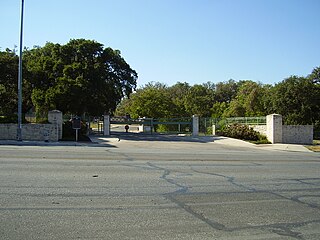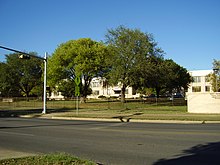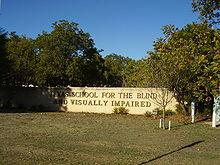Perkins School for the Blind, in Watertown, Massachusetts, was founded in 1829 and is the oldest school for the blind in the United States. It has also been known as the Perkins Institution for the Blind.

The Texas Department of Assistive and Rehabilitative Services (DARS) was a Texas state agency that was part of the Texas Health and Human Services Commission. The agency worked with Texans with disabilities and children with developmental delays to improve the quality of their lives and to enable their full participation in society.
The Louisiana School for the Deaf is a state school for deaf and hard-of-hearing students in Louisiana, located in Baton Rouge, the state capital. It was established in 1852 as a joint school for blind students. In 1860, its first purpose-built facility was completed and admired as an elegant monument to philanthropy. The schools were divided in 1898, and in 1908, Louisiana School for the Deaf was renamed.

Iowa Braille and Sight Saving School was a state-operated school for the blind. It was replaced by the Iowa Educational Services for the Blind and Visually Impaired. Vinton, Iowa, hosted the school and continued as host of the state agency that replaced it until 2020.

The Florida School for the Deaf and the Blind (FSDB) is a state-supported boarding school for deaf and blind children established in 1885, in St. Augustine, Florida, United States.
The South Dakota Services for the Deaf (SDSD) is a state agency that supports deaf children in South Dakota. Formerly it was a state-supported school located in Sioux Falls, South Dakota that provided services to meet the educational needs of children who are deaf, hard-of-hearing, or have cochlear implants. SDSD is governed by the South Dakota Board of Regents.

Ohio State School for the Blind is a school located in Columbus, Ohio, United States. It is run by the Ohio Department of Education for blind and visually impaired students across Ohio. It was established in 1837, making it the nation's first public school for the visually impaired.

The California School for the Blind is a public educational institution for blind children, K-12, located in Fremont, California. Its campus is located next to the California School for the Deaf.

The Maryland School for the Blind (MSB) is a school in Baltimore for children and youth who are blind or Low-vision, including those with multiple disabilities.

The Neill–Cochran House Museum is a historic home in north-central Austin, Texas. Master builder Abner Cook designed and built the house in 1855 as a suburban estate many years before the surrounding area was settled by other homes and businesses. The two-story Greek Revival home features prominent Doric columns and Mr. Cook's signature "sheaf of wheat" balusters.

Kansas State School for the Blind (KSSB) is a fully accredited public high school located in Kansas City, Kansas, U.S., serving students in grades Pre-K through 12. The school was established in 1867. It is located on 10 acres (40,000 m2) located in downtown Kansas City, Kansas. It opened its doors in May, 1868 and admitted the first five students.
The Vermont Center for the Deaf and Hard of Hearing, a non-profit organization, was the primary educational and support services resource for Deaf and Hard of Hearing residents in Vermont and surrounding areas. The Vermont Center, headquartered at Brattleboro’s Austin’s School For The Deaf, was launched by the Austine School in 1998 and operated until 2014. The Austine School was one of four independent schools and twelve outreach programs through which the Vermont Center assisted thousands of Deaf Vermonters.

Texas School for the Deaf (TSD) is a state-operated primary and secondary school for deaf children in Austin, Texas. Opened in 1857 "in an old frame house, three log cabins, and a smokehouse", it is the oldest continually-operated public school in Texas. The school struggled under inadequate funding during the American Civil War, and its aftermath, with the students eating food that they grew themselves on the school farm. In 1951 the State Board of Education assumed oversight of the school.

The New Mexico School for the Blind and Visually Impaired is a state special education school with a residential campus in Alamogordo, New Mexico and a preschool in Albuquerque, New Mexico. It operates outreach programs throughout the state.
The Arizona State Schools for the Deaf and the Blind(ASDB) is an Arizona state agency, with its administrative headquarters in Tucson. It operates three schools for the deaf and blind, and five regional cooperatives throughout the state:

The Arkansas School for the Blind and Visually Impaired, is a state-run public school in Little Rock, Arkansas, United States, serving blind and vision impaired students of kindergarten through high school grades through residential, day school, and part-time enrollment programs.
The Council of Schools and Services for the Blind (COSB) is a consortium of specialized schools in Canada and the United States whose major goal is improving the quality of services to children who are blind and visually impaired.

Western Pennsylvania School for Blind Children (WPSBC) is a private chartered school in Pittsburgh, Pennsylvania for individuals with blindness and visual impairment. It serves nearly 500 individuals ages 3 to 59 from 33 counties through on-campus school programs, A Child’s VIEW inclusive childcare, LAVI adult program, residential program and outreach services.
Texas Blind, Deaf, and Orphan School was a school for blind and deaf black people in Austin, Texas. Throughout its history, due to educational segregation in the United States, the school served only black students and had black teachers; whites attended the Texas School for the Deaf (TSD) and the Texas School for the Blind and Visually Impaired (TSBVI).

The Little Campus is a historic district and part of the University of Texas at Austin campus in Austin, Texas. Originally built in 1856 as the Texas Asylum for the Blind, the complex was used for a variety of purposes through the late nineteenth and early twentieth centuries. It was acquired by the University of Texas after World War I and listed on the National Register of Historic Places in 1974.














